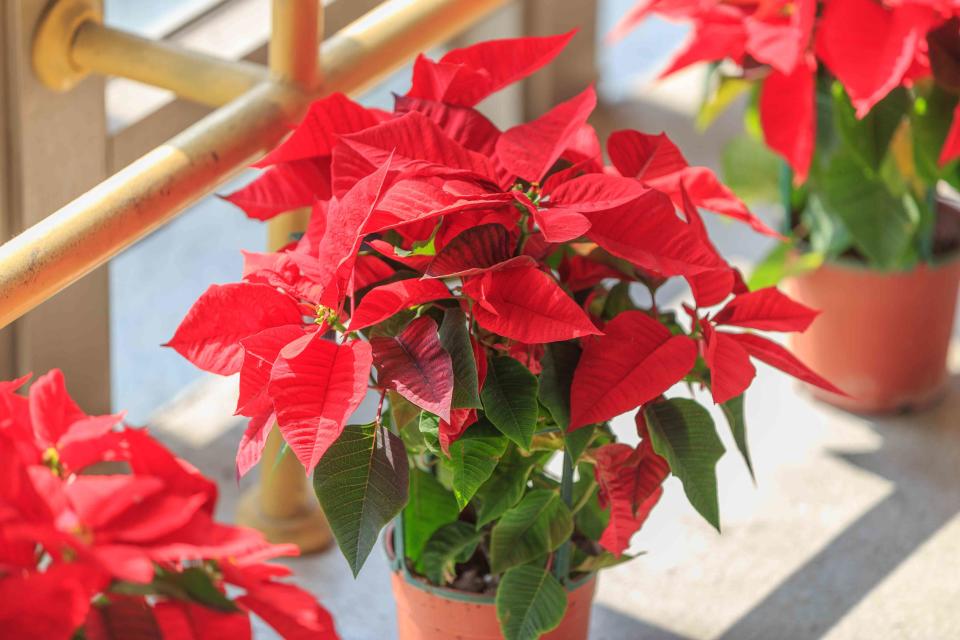How To Care for Your Poinsettias This Holiday Season
The popular Christmas plant can survive well into the new year with these expert tips.

JC Visual Studio/Getty Images
These ruby red beauties are plentiful during the holidays—they seemingly pop up everywhere once Thanksgiving is over, and there’s a good chance you’ve purchased or received a few as gifts in the past! Because they bloom when the days are shorter, they’re perfect plants for Christmas.
Related: 18 Christmas Flowers and Plants Perfect for Decorating and Gifting
Despite its wintry reputation though, did you know that poinsettias are actually a tropical plant that are native to Mexico? Did you also know those red “petals” on top are actually leaves (called bracts) and that the little yellow bead-like clusters throughout are technically the flowers of the plant? Learning some background information on poinsettias can help you take better care of these leafy holiday decor staples. Read on to find how to maintain a potted poinsettia so it thrives through January—and possibly even beyond.
How to Care for a Potted Poinsettia
Picking Out a Healthy Plant
Whether it’s for you or someone else, you want to make sure you choose one that’s healthy from the start. “Look for vibrant and well-colored specimens. Examine the plant for any signs of damage, such as broken stems, leaves, or bracts, as this may indicate mishandling or neglect,” says Bj Ryan, the live goods merchant at The Home Depot. Inspect the lower leaves too to ensure they’re all intact, and choose plants with little or no yellow pollen to get the longest-lasting poinsettias.
Taking Your Poinsettia Home
If you live in a cold climate, bring your poinsettia home as soon as you can—don’t let it sit in your car while you run errands! Remember, it’s a tropical plant. Once you’re home, remove any plastic or foil wrapping. Keeping it on for extended periods of time can lead to yellowing and leaf drop. You can place the pot on a shallow dish that you regularly drain after watering.
The Best Light and Location
Poinsettias thrive in bright, indirect sunlight. (Direct sunlight can harm the leaves.) Ryan says, “In your home, select a location such as near a window that receives up to six hours of daily light.” East-facing windows are best, though the leaves should never touch the glass. Ryan adds that you should avoid placing them in areas exposed to drying drafts like heating vents and radiators.
Selecting the Right Temperature
The best temperature most of the time is actually what’s comfy for humans! According to Ryan, poinsettias flourish in a temperature range of 60 to 70 degrees Fahrenheit, with nighttime temperatures staying above 55 degrees Fahrenheit. You can transfer your poinsettia to a cooler area in the house at night if you’d like; if you want to store it outside in the evenings, only do so if the temperature doesn’t dip below the mid-50s.
How Often to Water Poinsettias
Dialing in the watering schedule for your plants is always a little tricky, but Ryan suggests watering your poinsettias every three to seven days when the soil feels dry to the touch. “Be careful not to overwater, as excessive moisture can lead to root diseases and leaf loss,” he says.
His best watering hack is to use ice cubes to allow the water to slowly absorb. For a five-inch pot, you can use five ice cubes and for a seven-inch pot, use seven ice cubes. Make sure to use a pot with drainage holes to let excess water escape, he cautions. (You can water your plant in the sink or if it’s on a saucer, empty it about an hour after watering.) Ryan’s other watering tip: Water the soil and not the plant leaves because that could result in spotting.
Common Diseases and Pests
Ryan says common pests that can affect poinsettias include small insects such as whiteflies and aphids, among others. “Poinsettias may also be susceptible to diseases like powdery mildew, which can cause leaf distortion and root rot, leading to symptoms like wilting, yellowing leaves and a decline in overall plant health,” he adds.
Maintaining Them Past the Holidays
Poinsettias are typically considered a temporary plant—if you want to keep yours around past January, know that it’s possible but very hard to get them to rebloom! It requires constant pruning, fertilizing, and even a period of covering up the plant at night daily. But if you’ve grown too attached to compost your poinsettia, you can follow this helpful growing schedule suggested by University of Minnesota to stimulate rebloom.
Planting a Poinsettia Outside
Let’s say you want to plant your poinsettia outside—how should you go about it? For starters, you should know that poinsettias do well in USDA Hardiness zones 9 to 11, so if you don’t live in those areas, it might not be worth the effort to add this plant to your garden.
If you do live in those zones though, Ryan says to transition poinsettias, nurse the plant through the remaining winter months and wait to plant them outside until the weather warms up in spring. “Keep in mind that they must be gradually acclimated to outdoor conditions,” he warns. He suggests placing them in a shaded or partially shaded area for a few hours each day, then increasing their exposure to sunlight over a period of one to two weeks.
Are Poinsettias Toxic?
Contrary to popular belief, poinsettias are not actually poisonous to humans or pets. According to Poison Control, the poinsettia has very little effect, if any, when swallowed. That being said, it may cause mild irritation if ingested, and some gardeners have reported sensitivities to the sap after handling. Store your plant away from pets and small children to avoid any issues.
Related: 10 Plants That Bloom in Winter for Some Cheer During the Coldest Time of Year
For more Real Simple news, make sure to sign up for our newsletter!
Read the original article on Real Simple.


